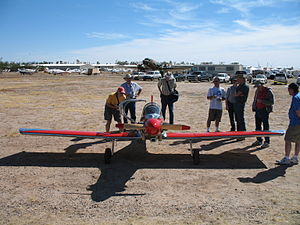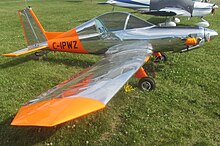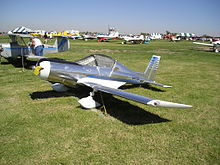250:
225:, United States. It is a single-seat, single-engine, all-metal airplane typically powered by a 1/2 VW engine in the 32 hp-45 hp range although other engines have been used successfully. It is built from plans, but many of the components are available pre-made from Hummel Aviation. Examples have been built for less than $ 4,000 with extensive "scrounging", but with all new material and a pre-built engine, a more likely figure would be $ 8,000–$ 10,000.
128:
242:
22:
234:
321:
so taildragger gear became a popular option. There were other changes as well, compromising a significant improvement over the wind wagon. He finished his project in July 1980. In July 1982, the plane was featured in an article written by Jack Cox, of Sport
Aviation. Jack dubbed Morry's new creation
351:
The standard location of the fuel tank is forward of the instrument panel. Some builders have moved it to the leading edges of the wings. By creating a sealed leading edge tank, the fuel is moved away from the pilot for better crash survivability with the added benefit of more than doubling the fuel
325:
Originally builders had to buy
Windwagon plans as well as Hummel's modifications and try to incorporate the two. This proved very difficult. One of those builders was Bill Spring. An engineer by profession, Spring took a great many photos and consulted with Morry Hummel until he had the complete
312:
was increased, the thickness of the skin was reduced, and the skins get even thinner toward the tips. The ribs are now a two piece design with one in front of the spar(nose rib) and one between the spars(main rib). The skins are riveted to the spars leaving no bump where the one piece ribs
294:
In the fall of 1979, Morry Hummel, who worked in the Curtis Wright experimental department during World War II, purchased the plans for Gary Watson's
Windwagon and the development of the "Hummel Bird" began. Because of the weather in Hummel's state of Ohio, a canopy was needed. The
368:, an engine literally made by cutting the block of a standard four-cylinder VW engine in half. After machining and welding, the remaining two-cylinder engine is light and powerful. Alternative engines include the more powerful but heavier four-cylinder VW engine, the two-stroke
291:. The Windwagon fuselage is smaller and is essentially a union of two cones. One that starts at the seat back and tapers to the back bulkhead and another that tapers forward of the seat back to the firewall. This design element would carry on to the Hummel Bird.
299:
attach construction was redesigned. The seat back was raised 5 inches so a shoulder harness could be added, and the instrument panel was raised 2 inches, increasing fuel capacity and leg room. The wing was completely re-engineered. The
333:. Its empty weight exceeds the specified 254 pounds, it carries more than 5 gallons of fuel, it stalls at a speed above 24 knots, and its top speed is well beyond the ultralight limit of 55 knots. In Canada it does meet the requirements for a
304:
break on the
Windwagon was in the middle; Morry made the center wing section straight and put the dihedral break at the point where the outer wing panels bolt to the center section. The Hummel Bird
308:
is built up of 1/8 6061-t6 aluminum angle spar caps, with a .040, 2024-t3 spar web. The spar cap angles are doubled in the center section, and tapered in the outer panels. The number of
358:
The plans state that a builder can increase the width and/or height of the bulkheads in an effort to make the fuselage more hospitable for larger pilots.
702:
270:
May 1971. Plans for the Teenie Two were originally offered for sale in 1969 and are still offered today with more than 12,000 sets sold.
330:
772:
280:
105:
326:
design. He then created CAD drawings and a builders manual which now comprise the plans package available from Hummel
Aviation.
583:
43:
249:
695:
86:
279:. Designed by Gary Watson, the windwagon shares a great deal of the design elements of the Teenie Two and debuted at the
58:
39:
767:
334:
65:
633:
32:
318:
608:
688:
153:
72:
480:
2-cyl. air-cooled horizontally opposed piston engine, 32 hp (24 kW) to 45 hp (33.6 kW)
529:
314:
296:
275:
54:
746:
741:
385:
313:
previously pushed the skin up where it crossed the spar. Both the Teenie Two and the
Windwagon had
301:
205:
541:
300 ft (91.4 m) (over 50 ft (15.2 m) obstacle) – 1,000 ft (304.8 m)
284:
138:
266:
261:
191:
711:
305:
218:
163:
666:
79:
477:
309:
253:
127:
761:
365:
241:
587:
217:
is an experimental/amateur built aircraft designed by Morry Hummel and produced by
222:
21:
726:
675:
373:
736:
233:
201:
637:
501:
87 kn (100 mph, 160 km/h) to 115 mph (185.1 km/h)
288:
372:
447, and even the McCulloch 0-100-1 drone engine popular with the early
449:
444:
612:
264:. Originally designed by Calvin Parker, the design was featured in
680:
369:
287:
in 1978. The most obvious variation from the Teenie Two is in the
260:
The Hummel Bird is a derivative of an earlier design known as the
248:
240:
232:
684:
15:
565:
661:
364:
The standard engine for the design is the four-stroke,
245:
Hummel Bird with custom AeroMorph engine and round cowl
329:
Despite the misconception, the Hummel Bird is not an
719:
46:. Unsourced material may be challenged and removed.
345:Some notable variations of the aircraft include:
273:The next generation of the design was called the
669:The Hummel Bird: Here am I sitting in a tin can
696:
8:
703:
689:
681:
534:.060 to .084 hp/lb (0.0986 to 0.138 kW/kg)
495:126 kn (145 mph, 233 km/h)
106:Learn how and when to remove this message
557:
513:170 nmi (200 mi, 320 km)
507:33 kn (38 mph, 61 km/h)
322:the “Hummel Bird” and the name stuck.
117:
428:13 ft 4.0 in (4.064 m)
7:
44:adding citations to reliable sources
434:18 ft 0 in (5.486 m)
440:57.2 sq ft (5.31 m)
14:
584:"ROWE AVIATION :: Airplanes"
281:Experimental Aircraft Association
676:YouTube video of the Hummel Bird
470:6 US gal (22.7 L)
126:
20:
256:engine mounted in a Hummel Bird
237:Hummel Bird with half-VW engine
31:needs additional citations for
1:
519:10,000 ft (3,000 m)
331:ultralight aircraft in the US
547:– 800 ft (243.8 m)
395:Specifications (Hummel Bird)
422:230 lb (104.3 kg)
317:, however, Morry preferred
789:
335:Basic Ultralight Aeroplane
464:530 lb (240 kg)
458:300 lb (136 kg)
319:conventional landing gear
125:
120:
773:Hummel Aviation aircraft
154:United States of America
662:Hummel Aviation website
407:General characteristics
257:
246:
238:
315:tricycle landing gear
297:horizontal stabilizer
276:Watson GW-1 Windwagon
252:
244:
236:
40:improve this article
386:Hummel Ultracruiser
206:Hummel Ultracruiser
768:Homebuilt aircraft
671:, by James Grahame
667:The Retro Thing –
390:Ultralight variant
285:Oshkosh, Wisconsin
258:
247:
239:
139:Homebuilt aircraft
755:
754:
747:Ultracruiser Plus
634:"Hummel Aviation"
609:"Hummel Aviation"
570:www.teenietwo.com
267:Popular Mechanics
262:Parker Teenie Two
211:
210:
116:
115:
108:
90:
780:
705:
698:
691:
682:
649:
648:
646:
645:
636:. Archived from
630:
624:
623:
621:
620:
611:. Archived from
605:
599:
598:
596:
595:
586:. Archived from
580:
574:
573:
562:
539:Takeoff distance
517:Service ceiling:
488:
476:1 × Volkswagen
409:
188:
150:
142:Type of aircraft
130:
118:
111:
104:
100:
97:
91:
89:
48:
24:
16:
788:
787:
783:
782:
781:
779:
778:
777:
758:
757:
756:
751:
715:
709:
658:
653:
652:
643:
641:
632:
631:
627:
618:
616:
607:
606:
602:
593:
591:
582:
581:
577:
566:"TEENIETWO.COM"
564:
563:
559:
554:
535:
484:
405:
397:
382:
343:
231:
219:Hummel Aviation
204:
186:
164:Hummel Aviation
149:National origin
148:
143:
112:
101:
95:
92:
49:
47:
37:
25:
12:
11:
5:
786:
784:
776:
775:
770:
760:
759:
753:
752:
750:
749:
744:
739:
734:
729:
723:
721:
717:
716:
710:
708:
707:
700:
693:
685:
679:
678:
673:
664:
657:
656:External links
654:
651:
650:
625:
600:
575:
556:
555:
553:
550:
549:
548:
542:
536:
526:
520:
514:
508:
502:
496:
493:Maximum speed:
482:
481:
471:
468:Fuel capacity:
465:
459:
453:
441:
435:
429:
423:
417:
402:Hummel website
396:
393:
392:
391:
388:
381:
378:
342:
339:
254:1/2 Volkswagen
230:
227:
209:
208:
199:
195:
194:
189:
187:Developed from
183:
182:
179:
175:
174:
171:
167:
166:
161:
157:
156:
151:
145:
144:
141:
136:
132:
131:
123:
122:
114:
113:
28:
26:
19:
13:
10:
9:
6:
4:
3:
2:
785:
774:
771:
769:
766:
765:
763:
748:
745:
743:
740:
738:
735:
733:
730:
728:
725:
724:
722:
718:
713:
706:
701:
699:
694:
692:
687:
686:
683:
677:
674:
672:
670:
665:
663:
660:
659:
655:
640:on 2009-02-12
639:
635:
629:
626:
615:on 2009-04-19
614:
610:
604:
601:
590:on 2009-04-16
589:
585:
579:
576:
571:
567:
561:
558:
551:
546:
543:
540:
537:
533:
531:
527:
524:
521:
518:
515:
512:
509:
506:
503:
500:
499:Cruise speed:
497:
494:
491:
490:
489:
487:
479:
475:
472:
469:
466:
463:
462:Gross weight:
460:
457:
456:Empty weight:
454:
451:
448:
446:
442:
439:
436:
433:
430:
427:
424:
421:
418:
415:
412:
411:
410:
408:
403:
401:
394:
389:
387:
384:
383:
379:
377:
375:
371:
367:
366:1/2 VW engine
363:
359:
357:
353:
350:
346:
340:
338:
336:
332:
327:
323:
320:
316:
311:
307:
303:
298:
292:
290:
286:
282:
278:
277:
271:
269:
268:
263:
255:
251:
243:
235:
228:
226:
224:
220:
216:
207:
203:
200:
197:
196:
193:
190:
185:
184:
180:
178:Introduction
177:
176:
173:Morry Hummel
172:
169:
168:
165:
162:
160:Manufacturer
159:
158:
155:
152:
147:
146:
140:
137:
134:
133:
129:
124:
119:
110:
107:
99:
88:
85:
81:
78:
74:
71:
67:
64:
60:
57: –
56:
55:"Hummel Bird"
52:
51:Find sources:
45:
41:
35:
34:
29:This article
27:
23:
18:
17:
742:Ultracruiser
731:
668:
642:. Retrieved
638:the original
628:
617:. Retrieved
613:the original
603:
592:. Retrieved
588:the original
578:
569:
560:
545:Landing roll
544:
538:
528:
522:
516:
510:
505:Stall speed:
504:
498:
492:
485:
483:
473:
467:
461:
455:
443:
437:
431:
425:
419:
413:
406:
404:
399:
398:
361:
360:
355:
354:
348:
347:
344:
328:
324:
293:
274:
272:
265:
259:
214:
212:
121:Hummel Bird
102:
93:
83:
76:
69:
62:
50:
38:Please help
33:verification
30:
732:Hummel Bird
486:Performance
478:½ VW engine
474:Powerplant:
229:Development
223:Byran, Ohio
215:Hummel Bird
762:Categories
644:2009-08-05
619:2009-03-12
594:2009-03-12
552:References
530:Power/mass
452:(modified)
438:Wing area:
376:builders.
374:gyrocopter
352:capacity.
341:Variations
283:fly-in in
192:Teenie Two
66:newspapers
523:g limits:
432:Wingspan:
420:Capacity:
400:Data from
356:Fuselage:
202:Hummel H5
198:Variants
170:Designer
96:June 2020
720:Aircraft
714:aircraft
380:Variants
362:Engines:
302:dihedral
289:fuselage
450:Clark Y
445:Airfoil
426:Length:
80:scholar
712:Hummel
511:Range:
82:
75:
68:
61:
53:
414:Crew:
370:Rotax
349:Fuel:
181:1982
135:Role
87:JSTOR
73:books
727:CA-2
310:ribs
306:spar
213:The
59:news
221:of
42:by
764::
737:H5
568:.
337:.
704:e
697:t
690:v
647:.
622:.
597:.
572:.
532::
525:6
447::
416:1
109:)
103:(
98:)
94:(
84:·
77:·
70:·
63:·
36:.
Text is available under the Creative Commons Attribution-ShareAlike License. Additional terms may apply.



